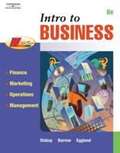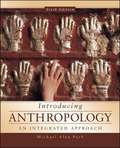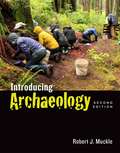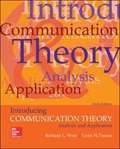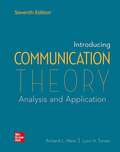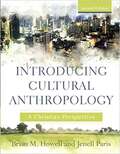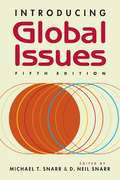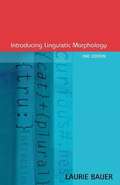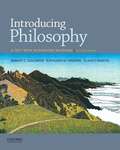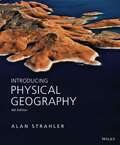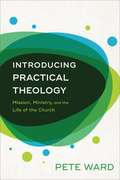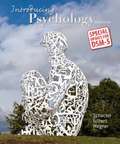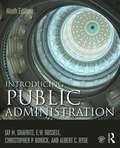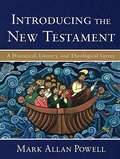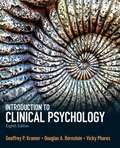- Table View
- List View
Intro to Business (Sixth Edition)
by James L. Burrow Les Dlabay Steven A. EgglandA complete revision of our market-leading text, INTRO TO BUSINESS introduces students to the role of business in the lives of individuals, consumers, workers, and citizens. Coverage includes small-business management, business fundamentals, career planning, social responsibility and ethics, basic economics, technology, financial operations, risk management, consumer decision-making, and insurance. This text is designed for the very first course many business students take; therefore, it covers business and finance topics with a survey-like approach.
Introducing Anthropology: An Integrated Approach, Sixth Edition
by Michael Alan ParkIntroducing Anthropology: An Integrated Approach is a concise text for the introductory-level, general anthropology course. The student-friendly format presents a unique holistic approach to anthropology, examining the biocultural nature, evolution, and behavior of the human species.
Introducing Archaeology (Second Edition)
by Robert J. MuckleIntroducing Archaeology offers a lively alternative to many other texts. While covering traditional elements of archaeology, including methods and prehistory, the book also integrates the key principles of curriculum reform for the twenty-first century, as outlined by the Society for American Archaeology. The second edition highlights recent developments in the field and includes a new chapter on archaeology beyond mainstream academia. It also integrates more examples from popular culture, including mummies, tattoos, pirates, and global warming. What results is a surprisingly fresh and contemporary take on archaeology, one that situates the discipline within, but also beyond, the academy. Introducing Archaeology is accompanied by a free website with chapter-by-chapter resources for students, including study questions. Visit www. introducingarchaeology. com. Instructor ancillaries for Introducing Archaeology include an instructor's manual, PowerPoint slides, and a testbank.
Introducing Communication Theory: Analysis And Application
by Lynn Turner Richard WestThis text introduces the field of communication to students who may have little or no background in communication theory. The three overriding goals of the book are to help students understand the pervasiveness of theory in their lives, to demystify the theoretical process, and to help students become more systematic and critical in their thinking about theory. Chapter by chapter approach allows students to understand one theory at a time, staying focused on one theory before learning another theory.
Introducing Communication Theory: Analysis and Application
by Richard WestIntroducing Communication Theory: Analysis and Application focuses on the links between theory and everyday experiences. This text uses an engaging writing style and a consistent, organized template to present the concept of theory and help students become insightful, critical thinkers. The Connect course for this offering includes SmartBook, an adaptive reading and study experience that guides students to master, recall, and apply key concepts while providing automatically graded assessments.
Introducing Cultural Anthropology: A Christian Perspective
by Brian M. Howell Jenell ParisWhat is the role of culture in human experience? This concise yet solid introduction to cultural anthropology helps readers explore and understand this crucial issue from a Christian perspective. Now revised and updated throughout, this new edition of a successful textbook covers standard cultural anthropology topics with special attention given to cultural relativism, evolution, and missions. It also includes a new chapter on medical anthropology. Plentiful figures, photos, and sidebars are sprinkled throughout the text, and updated ancillary support materials and teaching aids are available through Baker Academic's Textbook eSources.
Introducing Global Issues (5th Edition)
by Michael T. Snarr D. Neil SnarrThe conflict in Libya, concerns over Iran's nuclear program, the global recession, debates about climate change, the importance of human security, the growing impact of technology ... all are reflected in this new, fully revised and updated edition of Introducing Global Issues. The authors cover the full range of global issues, from conflict and security, to the economy and economic development, to the environment. The material has been successfully designed for readers with little or no prior knowledge of the topics covered. Each chapter provides an analytical overview of the issues addressed, identifies the central actors and perspectives, and outlines past progress and future prospects. Discussion questions are posed to enhance students¿ appreciation of the complexities involved, and suggestions for further reading additionally enrich the text.
Introducing Linguistic Morphology
by Laurie BauerA newly expanded and updated edition of one of the best-selling introductions to linguistic morphology -- the study and description of word formations in languages -- that deals with inflection, derivation, and compounding, the system of word-forming elements and processes in a language. Basic concepts are introduced, with an abundance of examples from a range of familiar and exotic languages, followed by a discussion of, among other topics, the definition of word-form, productivity, inflection versus derivation, and the position of morphology to phonology -- the science of speech sounds, especially the history and theory of sound changes in a language. Along with two new chapters discussing morphology and the brain and how morphology arises, changes, and disappears, this new edition includes exercises and a glossary of key terms.
Introducing Literature
by MacmillanA book that collates poems, songs, plays, stories among other literary works in the aim of introducing literature in an exciting and interesting way to the students.
Introducing Philosophy
by Clancy Martin Robert C. Solomon Kathleen M. HigginsThis book is an exciting, accessible, and thorough introduction to the core questions of philosophy and the many ways in which they are, and have been, answered. The authors combine substantial selections from significant works in the history of philosophy with excerpts from current philosophy, clarifying the readings and providing context with their own detailed commentary and explanation. Spanning 2,500 years, the selections range from the oldest known fragments to cutting-edge contemporary essays. Organized topically, the chapters present alternative perspectives--including analytic, continental, feminist, and non-Western viewpoints--alongside the historical works of major Western philosophers.
Introducing Philosophy: A Text with Integrated Readings
by Clancy Martin Robert C. Solomon Kathleen M. HigginsThe authors combine substantial selections from significant works in the history of philosophy with excerpts from current philosophy, clarifying the readings and providing context with their own detailed commentary and explanation.
Introducing Physical Geography
by Alan H. StrahlerIntroducing Physical Geography, 6th Edition is known for its clear writing, distinctive photos and illustrations and a strong supplements program. The text continues its tradition as a great book to help non-science readers visualize and understand earth processes and learn the basic language of physical geography. The new edition features a strengthened "Eye on Global Change" coverage and coverage of the geographers tool box.
Introducing Practical Theology: Mission, Ministry, and the Life of the Church
by Pete WardThis introduction to the field of practical theology reclaims a theological vision for the life and work of the church. Pete Ward dispels the myth that practical theology is a distraction from the "real" tasks of ministry or from serious academic theological work. He argues that practical theology is part of the everyday life of the church and that there are a variety of possible approaches, helping readers evaluate the approach that is most appropriate to their ministerial context and theological tradition. This reliable, accessible resource will work well for those in training or in ministry.
Introducing Psychology With Updates On DSM-5
by Daniel M. Wegner Daniel L. Schacter Daniel T. GilbertA great read is just the beginning. . . Instructor and student evaluations from coast to coast attest to the Dans' captivating writing These award-winning bestselling authors know how to enthrall students with the subject they love best--psychology But in the new edition of Introducing Psychology, they go even further to ensure that students won't commit one of the seven sins of memory--forgetting what they just read Special Cue Questions and Critical Thinking questions give students the opportunity to process psychological concepts and aid their understanding and memory And if you've ever heard someone parrot a widespread misconception, you'll welcome the new Changing Minds questions, short scenarios which ask students to confront common misunderstandings of psychological phenomena Now the book that students love to read is as unforgettable as ever! DSM 5 Updates Available for Fall 2014 classes, this update version features new content from the Dans in response to the release of the DSM-5. This new content is integrated into the text without changing pagination or the structure of the chapters. A special DSM 5 Supplement by the Matthew Nock, new coauthor with the Dans of Psychology, Third Edition, is available for Fall 2013 and Spring and Summer 2014 courses. View the Page-Referenced Guide to the DSM-5 updates for Psychology.
Introducing Public Administration (7th edition)
by Jay M. Shafritz Christopher P. Borick E. W. RussellIntroducing Public Administration provides students with a solid, conceptual foundation in public administration, and contains the latest information on important trends in the discipline.
Introducing Public Administration (9th Edition)
by Jay M. Shafritz E. W. Russell Albert C. Hyde Christopher BorickThis is the now the 9th edition of a text first published in 1997. There's only one audience for a book of this nature--practitioners, students and teachers of public administration. In the original preface to this book we explained that we sought to create a text that would bridge two worlds, a text that would be informal enough to be accessible to undergraduates yet comprehensive enough for graduate students.
Introducing Sociology class 11 - Goa Board
by Goa Board of Secondary and Higher Secondary Education Alto Betim GoaThe "Introducing Sociology" textbook for Class XI offers an introduction to sociology by exploring key sociological concepts and the discipline's relevance in understanding society. It emphasizes the interplay between individuals and the larger society, highlighting how personal issues often reflect broader social phenomena. The book covers topics such as social institutions, culture, socialization, and research methods, while addressing issues of inequality, stratification, and social change. It encourages critical thinking, using real-world examples to engage students in understanding how society functions and how they fit into it. The text integrates activities to foster reflection and active learning, promoting a deeper grasp of sociological perspectives.
Introducing Sociology class 11 - Meghalaya Board
by National Council of Educational Research and TrainingA great book for introducing students to Sociology, this Introducing Sociology Textbook will be ideal for the students, who are to appear for their final examination of class 11. The enriched content follows close parity with the syllabus and guidelines that have been set by the CBSE. Published by NCERT, it guarantees thorough learning in the form of easy to grasp, clear English.
Introducing Sociology class 11 - NCERT - 23
by National Council of Educational Research and Training"Introducing Sociology" for Class XI by NCERT is an introductory textbook that provides a foundational understanding of sociology to high school students. The book delves into the basic concepts, theories, and methods of sociology, aiming to acquaint students with the discipline's perspectives on society, culture, and human interaction. It explores topics such as the history and development of sociology, the significance of social institutions like family and religion, and the role of social stratification and social change in shaping human experiences. Through a combination of theoretical discussions, case studies, and real-life examples, the textbook encourages students to observe the world around them sociologically, questioning and understanding the social constructs that influence their daily lives. The content is presented in a student-friendly manner, fostering critical thinking and laying the groundwork for further study in the field.
Introducing The Old Testament
by Robert L. Hubbard J. Andrew DearmanThis book has been a long time in coming-too long, perhaps. But as the awesome and long-suffering novelist, Snoopy, once glumly observed, "Good writing is hard work!" Amen to that, Snoopy! But to emerge, a book needs more than just toiling authors who string thoughts into words; it also requires the wisdom, support, and encouragement of other people for it to see the light of day.
Introducing World Religions
by Victoria Kennick UrubshurowIntroducing World Religions offers an exciting new approach to the study of world religions. It explores the main religions of both East and West, situating them in a cross-cultural context and using a powerful dramatic metaphor to bring them alive for students. Ideal for one-semester or modular introductory survey courses, Introducing World Religions will be essential reading for any student of religions, worldwide.
Introducing the New Testament: A Historical, Literary, and Theological Survey
by Mark Allan PowellThis book offers an up-to-date New Testament introduction for undergraduate students and general readers. Powell presents disputed and controversial issues fairly, neither dictating conclusions nor privileging skepticism over faith-based perspectives. Includes helpful sidebars, maps, tables, charts, glossary, diagrams, and suggestions for further reading and beautiful artwork illustrating the reception of the New Testament through various times and cultures.
Introduction To Aircraft Maintenance
by Avotek ResourcesIntroduction to Aircraft Maintenance, the first textbook in Avotek's AMT Series, introduces the fundamentals of aviation maintenance to the beginning student. Written by a panel of aviation professionals for classroom instruction, this text tackles general curriculum subjects such as mathematics, physics and electricity as they relate to aviation, and it examines maintenance specific topics like aircraft inspections, weight and balance, human factors and documentation. <p><p> The breadth of coverage and the variety of topics included in this book go beyond the minimum requirements for 14 CFR Part 147 schools; they relate to actual applications and situations encountered in aviation maintenance industry.
Introduction To Attic Greek
by Donald J. Mastronarde<P><P>Thoroughly revised and expanded, Introduction to Attic Greek, 2nd Edition gives student and instructors the most comprehensive and accessible presentation of ancient Greek available. The text features: <P><P> • Full exposure to the grammar and morphology that students will encounter in actual texts <P><P> • Self-contained instructional chapters, with challenging, carefully tailored exercises <P><P> • Progressively more complex chapters to build the student's knowledge of declensions, tenses, and constructions by alternating emphasis on morphology and syntax <P><P> • Readings based on actual texts and include unadapted passages from Xenophon, Lysias, Plato, Aristophanes, and Thucydides. <P><P> • Concise introduction to the history of the Greek language <P><P> • Composite list of verbs with principal parts, and an appendix of all paradigms <P><P> • Greek-English and English-Greek glossaries
Introduction To Clinical Psychology
by Douglas Bernstein Vicky Phares Geoffrey KramerDesigned to provide a thorough survey of the field that is equally accessible to students with a general interest as well as to those with professional aspirations, this text presents a scholarly portrayal of the history, content, professional functions, and the future of clinical psychology.
